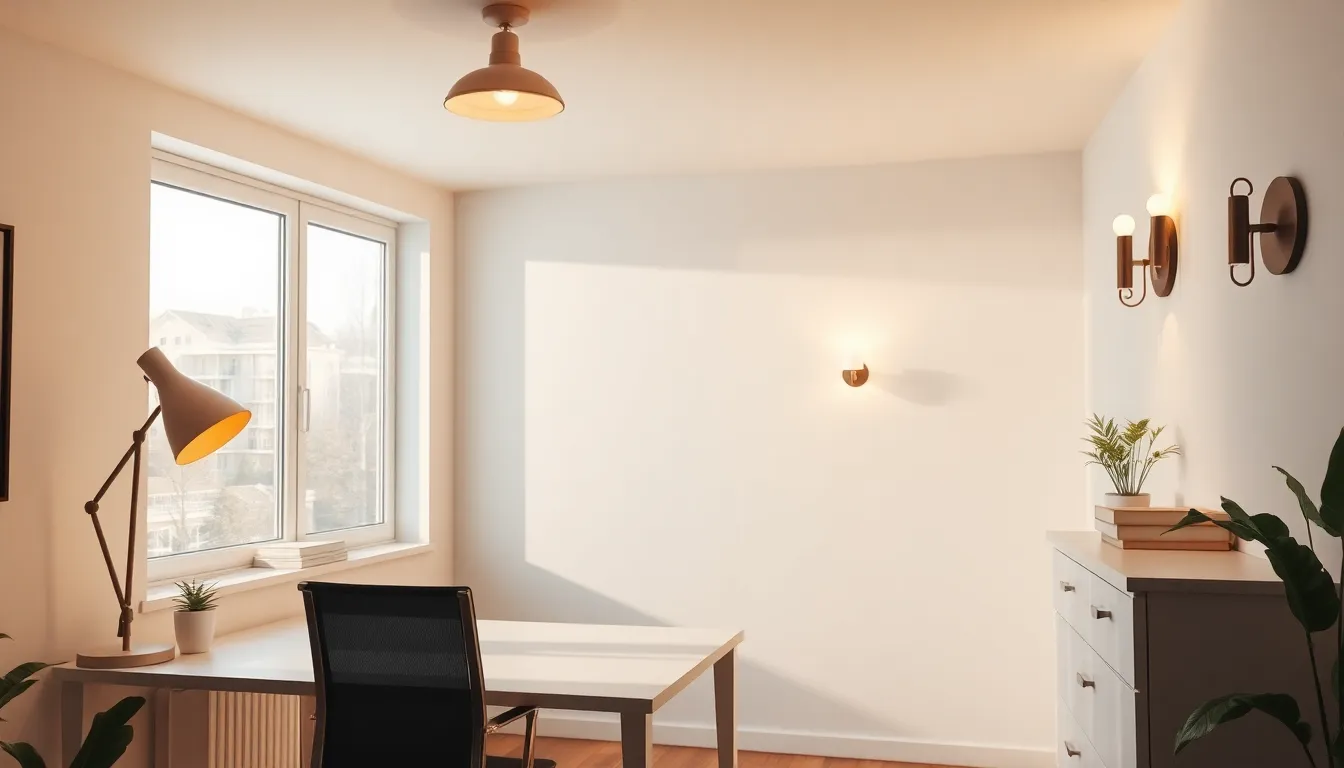Creating the perfect home office environment goes beyond just a comfortable chair and a sturdy desk. Lighting plays a crucial role in boosting productivity and enhancing overall well-being. The right lighting can reduce eye strain, elevate mood, and even inspire creativity.
In today’s remote work culture, understanding how to optimize lighting in a home office is essential. Whether it’s natural light streaming through a window or strategically placed lamps, the choices made can significantly impact focus and efficiency. This article explores practical tips on how to illuminate a home workspace effectively, ensuring it’s both functional and inviting.
Table of Contents
ToggleUnderstanding The Importance Of Home Office Lighting
Home office lighting significantly influences both productivity and well-being. Effective lighting prevents distractions and fosters a comfortable working environment.
Effects On Productivity
Adequate lighting directly affects focus and efficiency. Many studies show that well-lit spaces enhance task performance by 30%. Natural light increases energy levels, leading to higher productivity. A combination of ambient and task lighting can also prevent shadows and glares, making activities like reading or writing more effective.
Impact On Mood And Wellbeing
Lighting shapes the atmosphere in a home office, impacting mood and mental health. Bright, warm light stimulates feelings of happiness and motivation, while dim or harsh light may elicit fatigue or irritability. Research indicates that good lighting improves mental clarity, which contributes to better decision-making. Incorporating adjustable lighting options allows individuals to create a personalized, mood-enhancing environment.
Types Of Home Office Lighting

Effective home office lighting incorporates both natural and artificial light sources. Utilizing a combination of these two types enhances the workspace’s overall functionality and aesthetic appeal.
Natural Light Benefits
Natural light offers numerous advantages for home office environments. It enhances mood, increases energy levels, and substantiates focus. Exposure to sunlight boosts serotonin levels, which contributes to overall well-being. Studies indicate that employees who work in environments with natural light report a 15% increase in productivity. Positioning desks near windows optimizes the use of daylight, while strategically avoiding glare helps maintain comfort. Additionally, using sheer curtains can diffuse harsh sunlight, creating a pleasant ambiance while still allowing ample light to flow.
Artificial Lighting Options
Artificial lighting complements natural light and is vital in ensuring a well-lit home office. Various options are available:
- Ambient Lighting: This general lighting creates a warm base level of illumination. Overhead fixtures such as ceiling lights or recessed lighting serve as an effective choice for ambient lighting.
- Task Lighting: Task lighting focuses on specific areas, ideal for reading, writing, or other detailed work. Desk lamps or adjustable floor lamps provide direct light where needed, reducing shadows and increasing visibility.
- Accent Lighting: Accent lighting highlights specific areas or decor, enhancing the workspace’s visual appeal. Wall sconces or LED strips can create mood and style without overwhelming the primary light source.
Selecting the right artificial lighting involves considering brightness levels and color temperatures. A color temperature of 3000K to 4000K offers a balanced, natural feel suitable for most tasks, while higher temperatures (5000K to 6500K) provide a cooler light that can enhance alertness.
Choosing The Right Light Fixtures
Selecting appropriate light fixtures is essential for maximizing productivity and creating a comfortable home office. The right fixtures contribute to a well-lit environment that enhances focus and well-being.
Desk Lamps
Desk lamps serve as essential task lighting, providing focused illumination for activities like reading or writing. Look for adjustable lamps that allow for customizable brightness and positioning. Opt for LED bulbs to ensure energy efficiency and longevity. Adjustable color temperatures in lamps, ranging from 3000K to 4000K, create a conducive atmosphere for concentration. Consider lamps with built-in features such as USB ports for device charging and touch controls for convenience.
Overhead Lighting
Overhead lighting impacts the overall ambiance of the workspace. Use ceiling fixtures with dimmable options to control the brightness according to the time of day. LED flush mounts or pendant lights can provide even illumination across the room, reducing shadows. A combination of ambient and task lighting creates a balanced environment, preventing glare on screens and eye strain. When choosing overhead fixtures, consider incorporating smart lighting systems that allow adjustment via mobile devices or voice, providing versatility in lighting based on personal preferences.
Lighting Techniques For A Functional Workspace
Effective lighting techniques enhance workspace functionality. Implementing a balanced approach through layered lighting significantly improves comfort and productivity.
Layering Light
Layering light incorporates multiple light sources to create a dynamic illumination scheme. Combining ambient, task, and accent lighting allows for flexibility in adjusting to various tasks and moods.
- Ambient lighting provides general illumination. Ceiling fixtures or recessed lights distribute uniform light throughout the room.
- Task lighting focuses on specific areas, like desk lamps directed towards work materials. It minimizes strain during activities such as reading or writing.
- Accent lighting adds visual interest, highlighting artwork or shelves. It improves the aesthetic appeal while enriching the overall atmosphere.
Strategically placing these light types creates a well-rounded workspace that supports various activities.
Avoiding Glare And Shadows
Minimizing glare and shadows enhances comfort and focus in a workspace. Poor lighting conditions cause distractions, leading to decreased productivity.
- Position light sources carefully. Avoid placing bright lights directly above or behind workspaces to prevent glare on screens.
- Utilize adjustable fixtures. Dimmable lamps allow control over brightness levels, accommodating different tasks and reducing excessive light.
- Select appropriate shades and bulbs. Using frosted bulbs reduces harsh lighting, while shades can direct light away from reflective surfaces to minimize glare.
- Incorporate blinds or shades. Controlling natural light through adjustable window treatments enables users to manage brightness effectively throughout the day.
By addressing glare and shadows, individuals create a comfortable workspace that fosters concentration and efficiency.
Color Temperature And Its Effects
Color temperature significantly influences mood, focus, and productivity in a home office setting. Understanding the differences between warm and cool light helps individuals choose the right lighting for their workspace.
Warm Vs. Cool Light
Warm light, typically ranging from 2700K to 3000K, creates a cozy atmosphere, promoting relaxation and comfort. This type of light suits environments where one wants to unwind. In contrast, cool light, ranging from 4000K to 5000K, generates a bright and energizing environment, ideal for task-oriented activities. Research indicates that cool light enhances alertness and focus, making it preferable for work requiring concentration. Balancing warm and cool light through adjustable fixtures supports different needs throughout the day.
Optimizing Color Temperature
To optimize color temperature, incorporate adjustable lighting that allows for customization based on specific tasks. During morning hours, utilize cooler light to stimulate productivity and wakefulness. As the day progresses, transition to warmer light for a more relaxed mood. Aim for an overall color temperature of 3500K for a balanced feel in the workspace. Use smart bulbs to easily adjust hues and brightness, accommodating changing activities or times of day. This adaptability fosters an engaging and comfortable work environment conducive to sustained focus and creativity.
Creating the right lighting setup in a home office can significantly impact productivity and overall well-being. By combining natural and artificial light sources, individuals can craft a workspace that not only enhances focus but also uplifts mood. Utilizing adjustable fixtures and varying color temperatures throughout the day allows for a personalized environment that meets changing needs.
Incorporating layered lighting techniques ensures that every corner of the workspace is well-lit, minimizing distractions and maximizing comfort. With thoughtful consideration of light placement and types, a home office can transform into a dynamic and inviting space that supports creativity and efficiency. Prioritizing effective lighting is a crucial step toward achieving a productive remote work experience.




